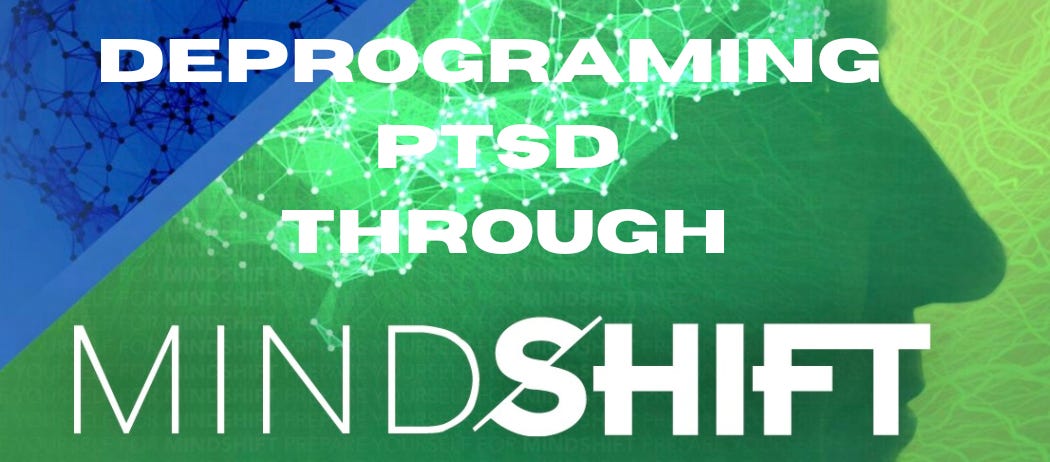MINDSHIFT
Have you ever found yourself reacting to a minor situation with intense anxiety, freezing up in important meetings, or people-pleasing to your detriment? These might not just be personality quirks—they could be trauma responses running on autopilot in your nervous system. The good news? You can break free from these patterns forever. Today, I'm diving deep into how the MINDSHIFT transformation program offers a revolutionary approach to deprogramming these ingrained trauma responses and reclaiming your authentic self.
Understanding Trauma Responses and Their Impact on Daily Life
Before we can effectively address trauma responses, we need to understand what they are. Most people associate trauma with major catastrophic events, but the truth is much more nuanced.
The Neuroscience Behind Trauma Responses
Trauma responses aren't character flaws—they're neurobiological adaptations your body implemented to keep you safe during perceived threats. When you experience something overwhelming (whether that's a car accident, childhood emotional neglect, or persistent microaggressions), your brain creates neural pathways designed to respond rapidly to similar situations in the future.
The brain's alarm system, the amygdala, becomes hypervigilant, while your prefrontal cortex, which is responsible for rational thinking, becomes less active. This effect creates a disconnect between your emotional reactions and logical thinking. The result? These automatic responses, which may have been helpful during the original trauma, now disrupt your daily functioning and happiness.
"The issue isn't that these responses existed in the first place," explains Dr. Rachel Thompson, neuropsychologist and MINDSHIFT developer. "The problem is that these emergency circuits stay activated long after the danger has passed, creating a constant state of dysregulation in your nervous system."
Common Trauma Responses You May Not Recognize
Many people carry around trauma responses without even recognizing them as such. Some of the most common include
People-pleasing and boundary difficulties: Saying yes when you want to say no, prioritizing others' needs above your own ,to feel safe
Emotional numbing: Difficulty accessing or expressing emotions, feeling disconnected from your body
Hypervigilance: Being constantly on edge, scanning environments for danger, struggling to relax
Freeze responses: "Deer in headlights" sensation during conflict or stress, brain fog, inability to think clearly
Fawning behaviors: Automatically adapting to others' moods and preferences to avoid conflict
Self-sabotage patterns: Unconsciously creating situations that confirm negative beliefs about yourself or the world
If any of these sound familiar, you're not alone. These responses developed as adaptations, not flaws—but they don't have to define your future.
What Is the MINDSHIFT Transformation Program?
MINDSHIFT isn't just another wellness trend or quick-fix approach to trauma healing. It's a comprehensive, neuroscience-based methodology explicitly designed to help people identify, understand, and ultimately deprogram automatic trauma responses.
Core Principles of MINDSHIFT
At its foundation, MINDSHIFT operates on five core principles:
Mind-Body Integration: Recognizing that trauma lives in both psychological patterns and physical sensations
Incremental Nervous System Regulation: Gradually building capacity for emotional regulation rather than forcing exposure
Neuroplasticity Activation: Deliberately creating new neural pathways through consistent practice
Developmental Gap Filling: Addressing unmet developmental needs that may have created vulnerability
Somatic Intelligence: Leveraging the body's wisdom as a pathway to healing cognitive patterns
"What makes MINDSHIFT different is that we're not just focusing on understanding trauma intellectually," says Thompson. "We're actively rewiring the nervous system's default settings through embodied experiences and consistent pattern interruption."
How MINDSHIFT Differs from Traditional Therapy
While traditional talk therapy has essential benefits, MINDSHIFT approaches trauma healing from a different angle:
Traditional Therapy
MINDSHIFT Approach
Primarily cognitive focus
Integrates somatic (body-based) and cognitive approaches
Often explores past events extensively
Emphasizes present-moment awareness and future patterning
Active participation in rewiring neural pathways
Weekly sessions with minimal between-session work
Daily micro-practices to create consistent neural change
The therapist as expert guide
Collaborative approach emphasizing self-regulation skills
As someone who's personally benefited from the MINDSHIFT approach, I can attest that the difference lies in how quickly you can interrupt patterns in realtime once you've been trained in these techniques.
The Five Stages of Trauma Deprogramming in MINDSHIFT
The MINDSHIFT program follows a systematic approach to unwinding trauma responses through five distinct but overlapping stages.
Stage 1: Mindful Awareness
The first stage focuses on developing what MINDSHIFT calls "response recognition"—the ability to catch your trauma responses as they begin to activate, rather than hours or days later. This involves:
Learning your physiological cues (racing heart, tight chest, shallow breathing)
Identifying emotional signatures of different trauma responses
Developing a "witnessing consciousness" that can observe reactions without judgment
Creating a personal inventory of response triggers and patterns
Many participants report that this stage alone creates significant relief. "Just being able to name what's happening as a trauma response rather than a personal failure changed everything for me," shares Jamie, a MINDSHIFT graduate. "That tiny moment of awareness creates space for choice."
Stage 2: Integration of Experiences
The second stage focuses on making meaning of your trauma responses—not just intellectually understanding them, but emotionally processing them in a way that allows integration.
During this stage, participants learn:
How to compassionately witness their response patterns
Techniques for emotional release without retraumatization
Methods to distinguish between past threats and present reality
Self-compassion practices specific to trauma responses
What makes this stage powerful is that it doesn't require detailed processing of past traumas. Instead, it focuses on recognizing how your system adapted and honoring that adaptation while creating space for new responses.
Stage 3: Neurological Rewiring
The third phase is where MINDSHIFT truly diverges from many other approaches. Stage three focuses on actively rewiring neural pathways through targeted practices:
Pattern interruption techniques for moment-to-moment response shifts
Nervous system regulation exercises calibrated to your specific response patterns
Embodied resource building to strengthen the parasympathetic nervous system
Incremental exposure practices with built-in regulation tools
"The brain follows the path of least resistance," explains Thompson. "We're creating new highways for your nervous system to travel down that don't lead to the old trauma responses."
Stage 4: Developmental Healing
Stage four addresses the developmental gaps that often underlie trauma responses. If specific emotional needs weren't met during key developmental windows, your system may have created adaptations to compensate.
During this stage, participants:
Identify specific developmental needs that remain unmet
Learn self-parenting techniques for different developmental stages
Create "corrective emotional experiences" through guided practices
Build internal resources that weren't developed during the formative years
This stage can feel particularly transformative as many people realize their responses weren't character flaws but adaptive attempts to meet legitimate needs.
Stage 5: Sustainable Habit Formation
The final stage focuses on embedding new patterns so profoundly that they become your new default settings. This involves
Creating personalized practice schedules based on your unique response patterns
Developing environmental cues for continued nervous system regulation
Building community and accountability systems for sustained change
Implementing "response replacement" strategies for challenging situations
"This isn't about perfect healing," Thompson emphasizes. "It's about creating sustainable change that continues to evolve as you build new neural pathways."
Real-Life Transformations Through MINDSHIFT
The most compelling evidence for MINDSHIFT's effectiveness comes from those who've experienced it firsthand.
Case Studies and Success Stories
Sarah's Journey from Freeze Response to Empowerment
Sarah, a marketing executive, came to MINDSHIFT after realizing she consistently froze during important meetings. Despite her high level of competence, Sarah would experience a classic freeze response when faced with a challenging situation.
"Despite my extensive preparation and thorough knowledge of the material, I would completely shut down when certain personalities were present," she explains. "It was like my brain went offline."
Through MINDSHIFT, Sarah discovered this response originated from childhood experiences with a critical parent. Her system had learned that silence was safety. Working through the five stages, she implemented
A pre-meeting somatic regulation routine
Subtle anchoring techniques during freeze moments
Micro-exposures to similar dynamics in controlled settings
New neural pathways connecting her expertise with confidence
Six months later, Sarah not only participates fully in meetings but recently led a presentation to the company's executive team—something previously unimaginable.
Michael's Path to Breaking People-Pleasing Patterns
Michael, a teacher, found himself exhausted from constant people-pleasing. He'd take on extra work, never set boundaries, and feel resentful yet unable to change.
"I knew intellectually I should set boundaries, but the moment someone asked for something, my mouth would say yes before my brain could intervene," he shares.
Through MINDSHIFT, Michael discovered that his people-pleasing was a fawning trauma response rooted in childhood experiences where emotional safety depended on managing others' emotions. His transformation included:
Learning to recognize the physical sensations preceding automatic "yes" responses
Practicing micro-moments of boundary setting in lower-stakes situations
Developing regulation techniques for the anxiety that arose when disappointing others
Creating new neural associations around safety and authentic expression
Today, Michael reports a complete transformation in his relationship to boundaries. "I still care deeply about others, but from a place of authentic choice rather than compulsive caretaking."
Implementing MINDSHIFT Techniques in Your Daily Routine
While the complete MINDSHIFT program offers comprehensive transformation, you can begin implementing some foundational techniques right away.
Quick Response Interruption Practices
These simple practices can help interrupt trauma responses in the moment:
The 3-3-3 Reset: When you notice a trauma response activating, identify three things you can see, three sounds you can hear, and move three parts of your body. This simple practice activates your prefrontal cortex and interrupts the amygdala's dominance.
Name and Locate: Verbalize what's happening ("I'm noticing I'm starting to freeze") and locate where you feel it in your body. This simple naming activates different neural circuits and creates space between stimulus and response.
Rhythmic Regulation: Create a rhythm with your breathing or gentle movement that's slower than your activated state. Your nervous system naturally entrains to rhythm, helping down-regulate activation.
Compassionate Hand: Place one hand where you feel the response most intensely in your body and silently acknowledge, "This is a response, not a truth about me. I'm safe now." The method combines touch and cognitive reframing for decisive intervention.
Building Your Personal MINDSHIFT Toolkit
Beyond in-the-moment techniques, consider creating a personalized toolkit:
Response Inventory: Document your common trauma responses, triggers, and physical sensations to build awareness
Resource Anchors: Identify and regularly practice connecting to resources that help you feel regulated (certain music, scents, movements, memories)
Boundary Scripts: Prepare language for setting boundaries in triggering situations
Regulation Routines: Develop short (2-5 minute) regulation practices for morning, mid-day, and evening
"Consistency matters more than duration," advises Thompson. "A 2-minute practice done daily rewires neural pathways more effectively than an hour-long practice done occasionally."
The Science-Backed Benefits of Deprogramming Trauma Responses
The benefits of deprogramming trauma responses extend far beyond emotional relief, impacting nearly every aspect of well-being.
Physical Health Improvements
Research increasingly shows that chronic trauma responses keep the body in states of hyperarousal or shutdown that contribute to numerous health issues:
Reduced inflammation markers: Studies show trauma-informed interventions can lower chronic inflammation, a root cause of many diseases
Improved immune function: As the nervous system regulates, immune function often normalizes
Better sleep quality: Reduced hypervigilance typically leads to improved sleep duration and quality
Decreased pain sensitivity: Many participants report reductions in chronic pain conditions
Normalized digestion: The gut-brain connection means that regulated nervous systems often experience improved digestive function
"Many people come to MINDSHIFT for emotional reasons but report their chronic health conditions improving as a secondary benefit," notes Thompson.
Enhanced Relationship Dynamics
Perhaps the most profound changes occur in relationships:
Increased capacity for authentic connection without old protective patterns
Ability to be present rather than triggered in challenging interactions
Improved communication about needs and boundaries
Reduced conflict stemming from trauma-based misinterpretations
Greater resilience during relationship challenges
"When you're not constantly managing trauma responses, you can be present with others," explains Thompson. "Relationships transform because you're relating from your authentic self rather than protective adaptations."
Conclusion: Your Path Forward with MINDSHIFT
Deprogramming trauma responses isn't about erasing your past or pretending difficult things never happened. It's about freeing yourself from automatic reactions that no longer serve you and reclaiming choice in how you respond to life.







